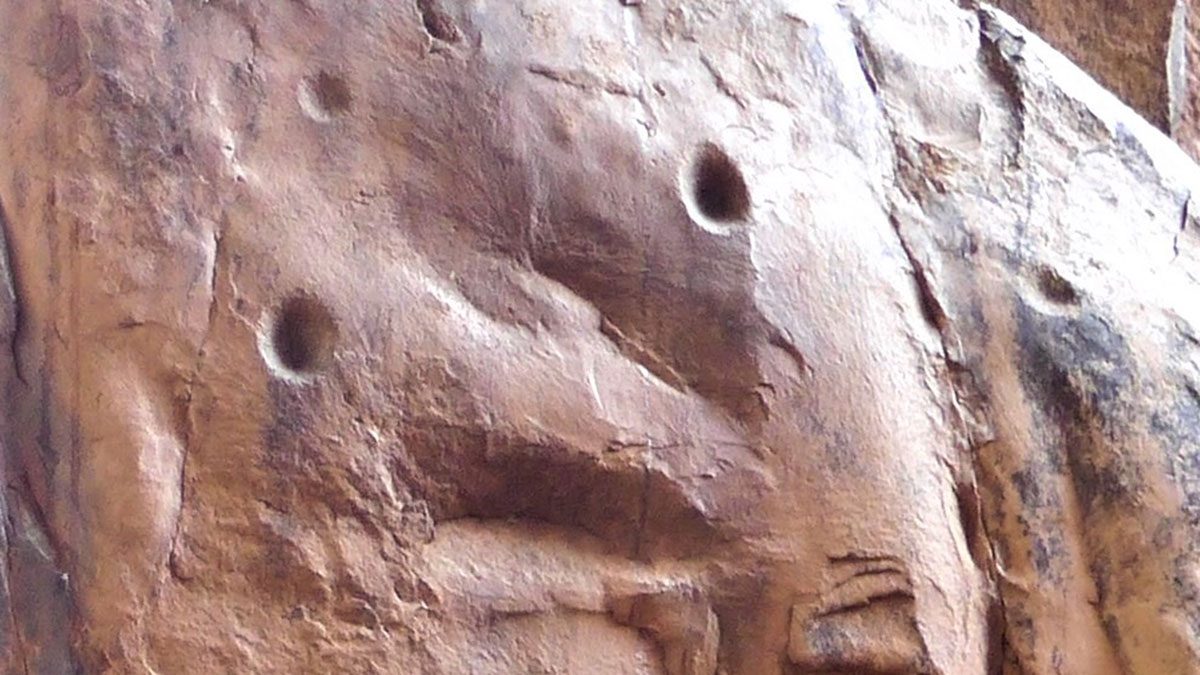Prehistoric Rock Art can be divided into two principal classes on the basis of the method used to manufacture it: petroglyphs, which are produced by a reductive process; and pictograms, which are produced by an additive process. Bhimbetka Petroglyphs in Madhya Pradesh, India are the oldest known rock art in the world. They refer to two petroglyphs, a cupule and a circuitous, hammered line. There are nine more cupules found nearby but their age can’t be established with certainty. We cover all the eleven petroglyphs in this article. It is also to be noted that Bhimbetka also has a plethora of rock paintings from the Mesolithic Era but they are not covered in this article.
Table Of Contents
The Key Questions
A petroglyph is a type of rock art which has been produced by removing part of the rock surface by pounding, incising, picking, carving, abrading etc. This is a reductive process unlike pictograms which are produced by adding a substance on the rock surface.
The word cupule comes from the Latin word cūpula. It means cup-shaped. In rock art, cupules are artificially made depressions on rock surfaces by humans and related species. Cupules were made by direct percussion or pounding. This was done by hand held stone tools. The earliest known rock art in the world are all cupules and they are found in all continents except Antarctica.
There is no agreed definition of what art is and transferring Eurocentric concept of Fine Arts to rock art is problematic as it is not scientific but philosophical and superficial. There are numerous rock markings and only two have been made by humans. All others are natural. Of the two, only one is regarded as rock art; which is intentional and not utilitarian. Cupules come under this category and hence it is considered as rock art by rock scientists.
S1 – Discovery
The Bhimbetka rock shelters are located in the Raisen District in the Indian state of Madhya Pradesh. They are about 45 km south-east of the state capital Bhopal. In 1957, while on his way to the city of Nagpur in a train, Indian archaeologist Dr. Vishnu Wakankar noticed these structures. The accidental discovery was followed by an expedition of a team of archaeologists led by Wakankar.
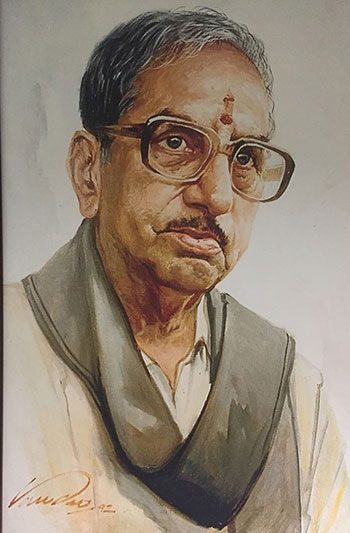
In 1990, renowned Australian prehistorian and cognitive archaeologist Robert G. Bednarik discovered two petroglyphs at Bhimbetka which were covered by Acheulian (Lower Paleolithic culture dated to about 1,500,000–150,000 years ago) deposit. This made their age at least Acheulian and this in turn makes the Bhimbetka Petroglyphs the oldest known rock art in the world.

S2 – Description
Auditorium cave is a central feature in the Bhimbetka site complex. In plain view the cave resembles a right angled cross. At the natural focus of this layout is a large boulder. It is clearly visible from all four entrances of the cave. It resembles a naturally formed altar. In recognition of its centrality, archaeologists have named the boulder Chief’s Rock. It is 2.5 m high and 3.4 m wide.
The boulder’s side facing the cave’s eastern passage bears a flat, near vertical panel. This panel is the most central feature of the entire cave. It is 2.2 m in height and measures over 5 square meters. On the panel, there are nine cupules of greatly varying depths from 1.1 mm to 13.4 mm. Mostly, their vertical extent is more than their horizontal extent.
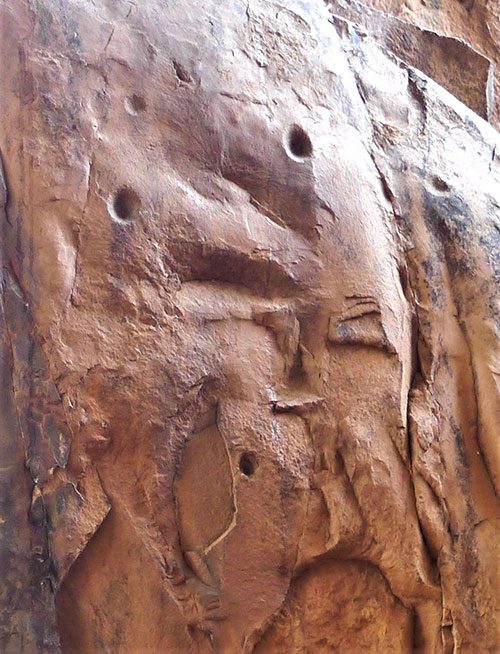
The deepest point of the cupules is below the center indicating that blow were dealt to them from above. The marks made are 1.5 m to 1.7 m above the platform, which is an ideal working height for an average size adult human.
A few meters to the south and below of Chief’s Rock, there are two petroglyphs which were exposed by excavation and discovered by Bednarik. One is another cupule; and the second is a circuitous, hammered line that wraps around part of the cupule’s periphery. They are hammered deeply into the extremely hard rock.
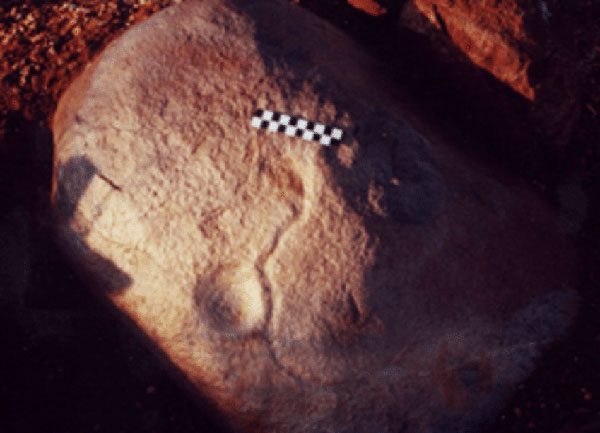
The cupule is almost perfectly circular and hemispherical. It measures between 78 and 80 mm in diameter and has a depth of 14.1 mm. The linear petroglyph associated has a width of about 9 mm and a depth of 4 mm. It measures 235 mm end to end. However, when stretched to a straight line, it has a total length of 295 mm along its central axis.
S3 – Age
The age of the petroglyphs discovered by Bednarik is beyond doubt Acheulian making them at least 150,000 years old. Their estimated age is 700,000 to 290,000 years making them the oldest rock art discovered till date. There is no clear evidence of the age of the nine cupules on Chief’s Rock.
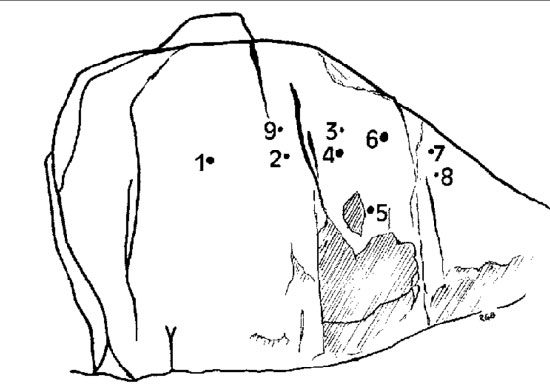
The two petroglyphs discovered by Bednarik are only a few meters from the nine cupules. Their confirmed Acheulian age may be suggestive of the age of these nine cupules, especially as one of them is also a cupule. This is not confirmatory evidence. However, it is highly improbable that these nine cupules were created in such close proximity after the two petroglyphs became invisible due to the Acheulian deposit. Other than these, the nearest known cupule in the entire region is around 50km away. Furthermore, scientific analysis of one of the nine cupules gives us a probable age of in excess of 100,000 years.
Main Sources
S1:-
Bhowal, Upasya. (Jun 22, 2020). “Bhimbetka: An Accidental Find”. Outlook Traveller.
Bednarik, Robert G. (1996). “The Cupules on Chief’s Rock, Auditorium Cave, Bhimbetka”. Australian Rock Art Research Association. p.64
S2:-
Bednarik, Robert G. (1996). “The Cupules on Chief’s Rock, Auditorium Cave, Bhimbetka”. Australian Rock Art Research Association. p.63–67.
Bednarik, Robert G. (2001). “The Oldest Known Rock Art In The World”. Moravian Museum. p.92
S3:-
Bednarik, Robert G. (1996). “The Cupules on Chief’s Rock, Auditorium Cave, Bhimbetka”. Australian Rock Art Research Association. p.67–70.

